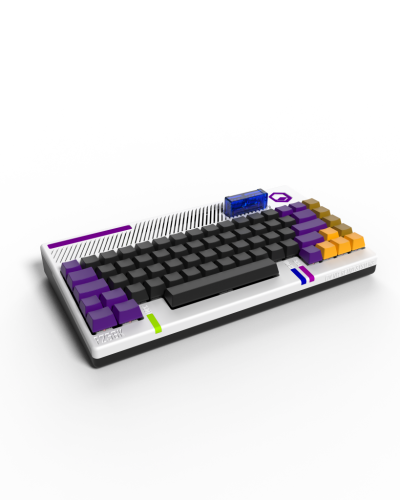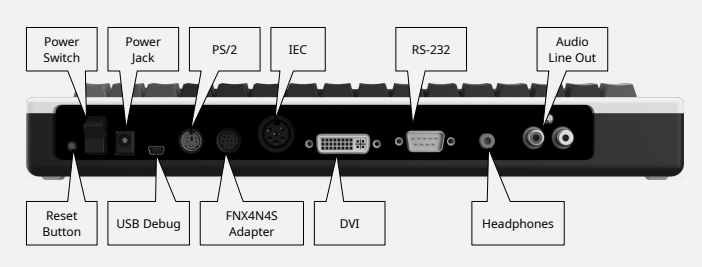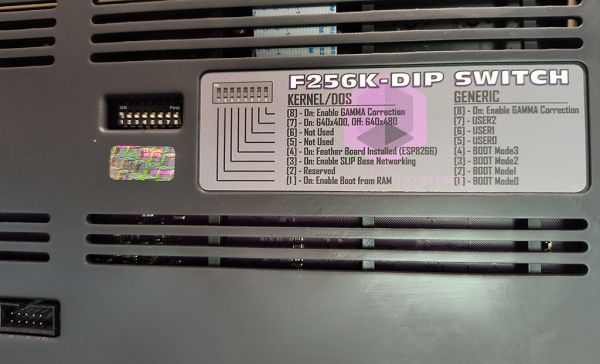F256K
The F256k is a 65xx-based system. It's an encased form factor with a built-in keyboard. It includes the following features:
- 512K of Shared System & Video RAM
- 256k of flash
- 256k of cartridge ram/rom
- TinyVICKY Graphic Chip (CFP9599)
- Port for connecting FNX4N4S, which can be used to connect Atari-Style Joysticks or NES/SNES gamepads
- 1x IEC Port to interface to Commodore Drives
- SID sound chip
It shares many similarities to the F256JR and programs may straightforwardly run on both.
The most common variety of the F256k uses the 6502 CPU. That said, the 65816 CPU can also be installed.
Ports and connectors
The back of the unit looks like this:
- Power Switch is a toggle-style switch to turn the unit off and on.
- Reset Button reboots the system, with values in RAM persisting. If RAM has been modified using the debug interface, it stays modified.
- Power Jack is for plugging in A/C power. Use, for example, a +12V or +9V with 2.5mm Barrel connector.
- USB Debug is for connection to a debug host computer, debugging F256k as a target, for example using a mini USB to USB A cable.
- PS/2 can be used for connecting external keyboard and/or mouse.
- FNX4N4S Adapter provides connections to gamepads (e.g., SNES-style game controller) through the FNX4N4S adapter.
- IEC provides connectivity to Commodore-compatible devices that use serial interface
- DVI is for connecting a display.
- RS-232 provides a standard RS-232 serial interface.
- Headphones is a standard 3.5mm headphone jack.
- Audio Line Out provides stereo audio output.
Switches
The bottom of the unit looks like this:
There are eight DIP switches, with different interpretations depending on whether a kernel is present on the system. If a kernel is present on the system, as the unit is shipped with, these switches are:
- [8] - On: Enable GAMMA correction
- [7] - Graphics resolution controls
- [6] - Not used
- [5] - Not used
- [4] - On: Feather Board installed (ESP8266)
- [3] - On: Enable SLIP Base Networking
- [2] - Reserved
- [1] - On: Enable Boot from RAM, off means it will boot from flash
If a kernel is not present on the system, these switches can be used as desired:
- [8] - On: Enable GAMMA correction
- [7] - USER2
- [6] - USER1
- [5] - USER0
- [4] - BOOT Mode3
- [3] - BOOT Mode2
- [2] - BOOT Mode1
- [1] - BOOT Mode0
Boot
To start the machine, ensure A/C power is plugged in and flip the power switch. The exact boot behavior depends on the "Boot from RAM" DIP switch on the bottom.
If the DIP1 "Boot from RAM" switch is off and a kernel is used, the kernel will search the 48K of memory for a pre-loaded kernel binary.
If the DIP1 "Boot from RAM" switch is on, then control is transferred to the reset vector entrypoint located at offset $FFFC.
Switching DIP1 to 'on' is useful for developer convenience and testing code. For those using the machine outside of a development-style environment, it's more likely the switch will be 'off'.
Kernels
There are three kernels for the F256k.
- The TinyCore MicroKernel (ships with the unit)
- OpenKERNAL (for those wishing to run software written for the CBM KERNAL)
- FoenixKERNAL, an open source, CBM-style layer also compatible with software written for Commodore 64 KERNAL


